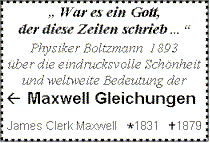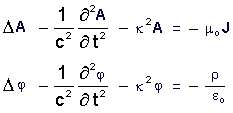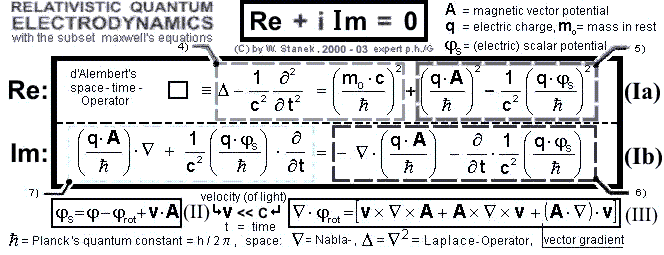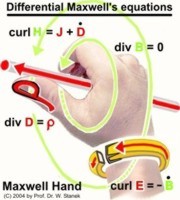|
Prof. Dr. Wolfram Stanek |
|
||||||||||||||||||
|
Advisor & Lecturer at SWISS
GERMAN UNIVERSITY BSD (Java) 2002 + 2003 |
||||||||||||||||||||
.
. |
||||||||||||||||||||
.
1.a) maxwell's equations (in rest - no movement of objects)
.
|
|
( Equivalent notation for vectoranalytic operation, i.e. rot H = curl H = Nabla x H )
In the above shown 4 equations is Nr. 1. Ampere's law (extended by Maxwell with displacement current),
Nr. 2. Faraday's law, Nr. 3: electric Gauss' law, Nr. 4: magnetic Gauss' law (source definition)
ATTENTION: For maxwell's equations considering NO moved bodies
the operators d / dt are only partial derivatives with respect to time (= d / d t )
The constitutive relations between the classical field terms D, E, B, H and J,
(including both polarisations P & M and external current sources Je) are defined by :
.
|
D
= e E + P
|
(5)
|
B
= m H + M
|
(6)
|
J
= g
E + Je
|
(7)
|
.
B is magnetic flux density, H
is magnetic field strength, D is the displacement, E is
electric field strength,
J is the electric current density,
r is the electric volume
charge density,
P is electric polarisation, M is magnetic Polarisation,
Je are external current sources
Material properties are the permittivity
e , the permeability
m and the electrical
conductivity g .
.
Einstieg : ELEKTRODYNAMIK
========================
Teil 1: Maxwellsche
Gleichungen
.
(ohne Relativitätstheorie + ohne Quantenmechanik)
in Basis-Form + universelle Erweiterungsmöglichkeiten
für
"klassische" elektromagnetische Felder
|
 |
||||||||||||||||||||
|
.
Größen im Durchflutungsgesetz, Induktionsgesetz, elektrische und magnetische Divergenz: Dielektrische Verschiebung D (->Maxwells "displacement"), elektrische Feldstärke E, magnetische Flußdichte B (->Induktion), magnetische Feldstärke H, elektrische Stomdichte J, elektrische Raumladungsdichte r . Die Ableitung von D ist die Verschiebungsstromdichte, die Ableitung von B entspricht magnetischen Flußdichteänderungen. |
|||||||||
|
.
. |
|||||||||
|
Nachstehende
Ableitungen führen zu den erweiterten nichtrelativistischen,
differentiellen Maxwellschen Gleichungen der klassischen Elektrodynamik unter Verwendung der elektromagnetischen klassischen Feldgrößen E, H, B, D. (Aus Webseite "relativistische Quantenelektrodynamik" wird jedoch ersichtlich, daß diese Feldgrößen nur abgeleitete Größen aus übergeordneten magnetischen Vektorpotentialen und neu formulierten elektromagnetischen Skalarpotentialen sind). |
|||||||||
Hinweis für folgende Ableitungen: |
|||||||||
|
|
(5a) |
|||||||
|
A ist ein VEKTOR B, D, ... oder ein SKALAR: j , m , e , g ... oder entsprechend ein TENSOR ... |
|
|
mit kartesischen Einheitsvektoren ex, ey, ez |
|||||||
Der rechte Klammer-Ausdruck von Gl. (5a) komprimiert notiert, für z.B. Induktion B : |
|
Vektor-Gradient :
|
|
(5b) |
||||||
|
|
(5c) |
|||||||
|
In kartesischen Koordinaten gilt für B |
|
|||||||
|
Vektoranalytische Identitäten |
|
|||||||
|
Der vektoranalytische Nabla-Operator für kartesische Koordinaten:
|
|
3-dim. Laplace-Operator (x,y,z)
4-dim. Laplace-Operator(x,y,z,t) |
|
|
(6) |
|||||
|
3 Verknüpfungsgleichungen:
|
D = e E + P |
B =
m
H
+
M
|
J =
g
E
+
Je
|
(7) |
||||
. Mit diesen Verknüpfungsgleichungen folgen in nichtrelativistischer
Formulierung |
1.b) maxwell's
equations
(extended for moved bodies)
.
Attention: considering moving
bodies the operators d / dt in the above shown maxwell's equations
1. - 4.
are both partial time derivatives and vector gradients as to
electrodynamic field terms & velocity.
Using vector analysis maxwell's equations 1. - 4. were extended and re-formulated
by W. Stanek as shown :
.
|
1.
extended maxwell's equation (fields)
Ampere-Maxwell's Law |
|
(1a)
|
|
2.
extended maxwell's equation (fields)
Faraday-Lorentz'-Law |
|
(2a)
|
|
3.
extended maxwell's equation (sources)
electric Gauss' Law |
|
(3a)
|
|
4.
extended maxwell's equation (sources)
magnetic Gauss' Law |
|
(4a)
|
|
using
classic electrodynamic field terms
for B, H, D, E etc work with area based vector analysis for field theory |
|
( * )
|
|
using
superior magnetic vectorpotential A
& scalar potential PHIs work with line based vector analysis for field theory |
grad (A.v) =
(v Nabla) A + (A Nabla) v + v x curlA + A x curlv |
( ** )
|
|
NOTE:
Symmetric structure of Maxwell Equations |
This shown re-formulation leads to a
symmetric structure
of Maxwell's equations (1a), (2a), (3a) and (4a). Similar to Dirac's suggestion to construct a set of symmetric Maxwell equations we automatically get both the electric charge density (Rho - Nabla.P) and(!) the magnetic charge density (-Nabla.M) |
|
(
* ) 1. EXAMPLE for evaluation
with magnetic flux density Terms : Derivation of Faraday-Lorentz'
Law
using equation ( * ) :
Assuming special conditions/restrictions
(-> in literature often not mentioned)
i.e. incompressible materials -> div v = 0,
space
independent constant movements -> (B grad) v = 0
and in magnetic fields directly from magnetic Gauss' law always -> div
B = 0 the remaining term on the
right side in equation
(
* ) yields -> rot ( B x
v ) = - rot ( v x B ) = - curl ( v x B
). Inserting this result in
Faraday's Law eq. (2a) we can simply derive the extended 2. Maxwell's
equation for moved bodies:
|
differential Faraday - Lorentz' - Law
|
curl E = - d B / dt = -
d B / d
t + curl (v x B)
|
(2b)
|
using
equation ( ** ) assuming same
condition mentioned above you also get eq. (2b) with Nabla x A
= curl A = B
The first term on the right side of this equation (2b) was proved by
Faraday, the second one by Lorentz.
NOTE: using this vector analytical
formulation you get the Lorentz-Term E = v x B
automatically !
The famous Lorentz law is therefore a (very important) vector IDENTITY
... but not really a separate physical LAW.
.
(
* ) 2. EXAMPLE for
evaluation with electric flux density Terms : Derivation of
Ampere-Maxwell's Law
using equation ( * ) :
Assuming special conditions/restrictions
(-> in literature often not mentioned)
i.e. incompressible materials -> div v = 0,
space
independent constant movements -> (D grad) v = 0
and in electric fields directly from electric Gauss' law -> div D
= r the remaining term on
the
right side in equation
(
* ) yields for the cross product
-> rot ( D x v ) = - rot ( v x D ) = - curl
( v x D )
and in opposite to Faraday-Lorentz' Law in this Ampere-Maxwell's Law an
additional term v div D = v
r
Inserting these results in Ampere-Maxwell's Law (1a)
we can derive
the extended 1. Maxwell's equation for moved bodies or particles:
|
differential Ampere - Maxwell's - Law
|
curl H = J + d D / dt =
J + d D /
d t +
v r
- curl (v x D)
|
(1b)
|
The first term on the right side of this equation (1b) was proved by
Ampere, the third term by Rowland,
the second term by Hertz (suggested and introduced by Maxwell), the
fourth term by Roentgen.
NOTE: using this vector analytical
formulation you get the "dualism" of Lorentz-Term H = - v
x D automatically !
The Rowland and Roentgen terms are therefore (important) vector
IDENTITIES ... but not really separate physical LAWS.
.
(
* ) 3. EXAMPLE: Proof
of extended 1. + 2. Maxwell's
equations
using famous HELMHOLTZ' formula
Helmholtz derived for any arbitrary vector flux X in physics
(i.e. hydrodynamics) through a moved ( v )
and simultaneously deformable area element in his curl laws - as a
subset of ( * ) - following formula
:
.
|
d
X / dt = d X /
d t + curl (X x v)
+ v
div X
|
( *** )
|
.
Inserting this
Helmholtz' formula (
*** )
in the
Maxwell equations (1a) and (2a)
- prerequisiting both the same above mentioned conditions/restrictions
and X = B alternatively X = D -
we immediately get the extended Maxwell's
equations (1b) and (2b) in the 1. and 2. example !
NOTE: using (
***
) the extended Maxwell's equations can be derived without any
knowledge in vector analysis !
.
2.
Maxwell's
equations considering quantum field theory
.
2.a)
Considering
relativistic quantum mechanics PROCA has developed following
extended maxwell's equations in quantum field theory -> the so-called
proca's equations
.
|
|
(8)
|
.
The difference between maxwell's equations in
classic field theory and quantum field theory is shown in red boxes.
The additional "red box" terms consist of magnetic vectorpotential A,
electric scalar potential PHI,
material properties in vacuum both permeability mue & permittivity eps.
The magnetic flux density B is equal to rot A = curl A
.
The special term k²
= Kapa² = (m0
c / hbar)²
is famous in quantum mechanics, because
Kapa is the Compton frequency devided by velocity c of light ... or
Einstein's energy in view of quantum mechanics.
The mass in rest (no relativistic movements) is m0, the universal
Planck's constant in quantum mechanics is hbar.
Note: These PROCA equations (8) can be also derived from unified
equation Re + i Im = 0 in section 3.
2.b)
The well known relativistic
Schrödinger equation, the so-called Klein-Gordon equation
is:

2.c)
Extending this homogeneous Klein-Gordon wave equation (
f = 0
) , applying a
probability function
Y
("PSI")
we get the non homogeneous Proca wave equations
( f not equal 0
)
.
|
General Proca wave equation
|
 |
(8a)
|
. Introducing magnetic Vectorpotential A and
scalar Potential PHI we can derive following wave equations :
..
|
Proca
wave equation = f ( A )
|
 |
(8b)
|
|
(8c)
|
||
|
Proca
wave equation = f ( PHI )
|
Using B = curl A and the constitutive relations
these equations (8a), (8b) or (8c) can be derived directly
from equations (8)
... or can be also evaluated from unified equation Re + i Im = 0 in
section 3
3.
"Right Hand Rules as Memo
Maps
for all central derivations from Maxwell's equations"
Central
derivations from Maxwell's equations
with respect to all important phenomena inside electrodynamics are
developed and visualized
as a new Mind Map with 10 memorable Memo Maps
based on variations of famous Maxwell's "Right Hand Rule".
.
Starting from differential equations we
can formulate all central equations
governing electrodynamics and interdisciplinary physics.
These Memo Maps are valuable mnemonics for necessary derivations.
Using these 10 special pictures it's easy to bear all derivations in
mind.
.

.
Variations of Maxwell's Hand as a MIND MAP with
MEMO MAPS
(C) 2004 by Wolfram Stanek
.
4.
Extended
Maxwell's equations as a subset derived from only (=1)
unified equation Re + i Im = 0 in relativistic quantum electrodynamics
.
The idea for the following relativistic equation was an impuls - energy
- quantum formulation on the basis of
Einstein's energy law, Newton's impuls law and Faraday's induction law
considering relativistic and arbitrary
movements of an electron. In all derivations no conventional
field terms D, E, B, H, J are explicitely used but only
the superior magnetic vector potential A & special formulation of
an EXTENDED scalar potential PHIs. In the
following relativistic equation for quantum electrodynamics i.e. the
maxwell's equations are embedded
"only" as a subset. In the case of maxwell's field theory as to real
part the term 5)
equals to zero yielding the light field wave gauge A = PHIs / c ->
( for v << c & PHIs = PHI the so-called Lienard-Wiechert's
potential A = v x PHI / c^2 ).
This real part gauge is also the condition for achieving the
relativistic Schrödinger's equation
-> Klein-Gordon's equation equals to term 4). As to imaginary part of
this equation
the Lorentz' gauge (including Coulomb's
gauge with PHIs = const) is directly seen,
if term 6) = 0. With these gauges we can simply derive all maxwell's
equations
in conventional field terms using also Maxwell's transformation B
= curl A
and the known constitutive relations.
Prerequisite for all mentioned re-formulations is an experienced
handling with operators in
vector analysis i.e. PHI (A) (line based fields) and
quantum mechanics
representated i.e. by impuls operator p and energy Hamilton
operator H :
|
unified theory operators
|
|
(10)
|
Additionally to Maxwell's equations (in rest and with moving bodies)
also Lorentz-Einstein's relativistic
energy relations, Newton's impuls mechanics, Proca's equations, (relativistic)
Schrödinger's equation
- > Klein-Gordon's equation, Bohm-Aharanov effects in quantum mechanics
etc
are integrated in this one equation " Re + i Im = 0 " :
.

.
SOME INTERPRETATIONS:
.
1. Real part Re of this equation shows the DUALITY of
classic waves (left side)
and quantum particles (right side).
2. Using the light field gauge term 5) = 0 and applying quantum
flux (hbar / charge q)
to the imaginary part Im the
re-formulated term 6)
yields the total electric field strength E = -
d A / d t
- grad ( PHIs ) ____________(9a)
with all influences (i.e. arbitrary translation, rotation, distortion
movements) in classic electrodynamics:
|
Total electric field strength
|
E = - d
A / d t - grad
j + ( v x curl A ) + [(
A x curl v ) + further terms (II+III)]
|
(9)
|
By this simple re-formulation of the imaginary
part Im we've automatically
changed the term 7) so that we also see the DUALITY of classic electric
field strength E
and quantum flux based alternative formulation in quantum
electrodynamics.
The 2. Maxwell equation = Faraday-Lorentz' law you get from (9) applying
the operator "curl".
A good excercise for you: Where are the
other Maxwell equations "hidden" in Re + i Im = 0 ?
.
3. Furthermore we have 6 possible
gauges for electrodynamic field defined by
div A = ... (eq. Ib) as combination i.e.
the simplest
gauges are Coulomb's gauge div A = constant and Lorentz' gauge
div A = -[d(PHI)/dt] / c^2
The important 7th gauge (in literature often not mentioned) is the light
field gauge term 5) = 0.
This light field gauge is a basis for classic electrodynamics.
But a further conclusion is, that PHOTONS (and GRAVITONS)
must have a rest mass m0 = 0, propagating with the velocity of light in
vacuum.
4. From real part < Re > we see a surprising (but measured)
phenomenon, that electrodynamics
can influence the mass of rigid bodies! The speed of rigid bodies
v
is always less then speed of light c. From eq. (1a) we can
conclude
that the gravitational masses of atoms in a material can be changed,
especially reduced
or nullified or even inverted under special
electrodynamic field conditions !
5. Using no classic field terms, i.e. E, H,
D, B or mixed terms like in Proca's equations
the equation Re + i Im = 0 in
quantum electrodynamics shows a
general result:
magnetic vector potential A and scalar potential PHIs are
superior,
classic field terms i.e. E, H, D, B are secondary because those
are
simply to derive from primarily A and PHIs equations.
6. Term 6) = 0 in imaginary part < Im > in above shown
equation Re + i Im = 0 implies not
only the Lorentz' gauge but also - choosing light field gauge term 5) =
0 -
the central basis for classical interdisciplinary physics.
.
Some examples for
interdisciplinary evaluations of imaginary part
< Im >
.
a) Directly from eq.(Ib) yields the special Lorentz gauge:
div A = - { d (PHIs) / dt/
} / c^2 ___(11a)___
or from eq.(Ib) unified equations i.e. using naturics UNIT checks:
div J = - d (RHO) / dt
_______(11b)___
or directly from (1b) with J = v
RHO
Zamanda yolculuk © 2005 Cetin BAL - GSM:+90 05366063183 -Turkey/Denizli
|
div ( v . RHO
) = - d (RHO) / dt
|
_(=11b)
|
.
It's clear, that you can get eq. (11b)
directly from Ampère-Maxwell's law applying operator "div":
div curl H = 0 = div J + div
[ d D /dt ] with electric Gauss' law div D = RHO:
Because of J = (current) FLOW and
RHO = (electrical charge) DENSITY = charge q / m^3
(analogous quick derivation as for the basic equation in mechanics in
the following lines)
eq. (11a) or (11b) can be written as an universal law:
.
div (FLOW DENSITY)
= - d (specific DENSITY) / dt
___(11)_
_
=> CONTINUITY law
.
FLOW DENSITY is based on electrodynamics,
thermodynamics or hydrodynamics etc., too ...
Specific DENSITY means the equivalent medium (charge, mass etc.
Eq. (11) can be re-formulated i.e. with respect to mechanics
|
div ( RHOm. v ) = - d (RHOm) /
dt
|
_(11c)
|
where RHOm
= Mass Density in mechanics as formal
equivalence with charge density in electrodynamics.
A separate quick development of new formulas can
be related to naturics based UNIT checks, i.e.
directly from eq. (Ib) for electrodynamics leading to eq. (11c)
governing mechanics:
RHO. A [As/m^3 Vs/m = Ws/m^3 s/m =
Nm/m^3 s/m = kg/m^3 m/s] = RHOm. v
__(11d)
RHO. PHIs / c^2
[As/m^3 V s^2/m^2 = Nm/m^3 s^2/m^2 =
kg m / s^2 m /m^3 s^2/m^2 = kg / m^3] = RHOm_(11e)_
Eq. (11d) and (11e) in eq. (1b) yields eq. (11c)
. .
b) additionally applying light field
gauge: d (q A) / dt = - grad (q PHIs)___(12a)
because of q A = Impuls and q PHIs = (potential)
energy eq. (12a) can be written as an universal law:
.
d (IMPULS) / dt =
- grad (ENERGY)
___(12)__
=> FORCE law__
.
eq. (12) or directly (11c) can be re-formulated
i.e. with respect to mechanics:
d (m v ) / dt = m dv / dt +
v dm / dt = - grad ( Wpot )___(12b)__
where m = Mass, v = speed of body, Wpot = m g h (i.e. and/or
other force-"sources")
.
NOTE: Regarding (11b), (11c) and (12) we can formally switch between
Newton's and Maxwell's relations
using Hamiltonian vector gradient formulation eq. (II), (III) shown
above in unified equation Re + i Im = 0
... always thinking in analogies.
HINTS:
Start from grad (A.v) = (v
Nabla) A + (A Nabla) v + v x curlA +
A x curlv
_____(12c) = (
** )
or simplify with A = v as needed
i.e. for NAVIER-STOKES equations in hydrodynamics you directly
get :
|
d v / dt -
d
v / dt
= (v
Nabla) v = grad
( v^2 / 2 ) - v x curlv
|
_(12d)
|
Using (12c), (12d) we can
compare important features of Maxwell equations
and Newton's law, too.
... it's a good excercise for you to test your capabilities in handling
vector analytic operations!
.
NOTE: 1.
Though the physicist Heinrich Hertz was convinced that Maxwell's
equations are not
derivable from Newton's equations, you can
prove it ... at least in a formal analogy
... useful for multiphysics applications in engineering.
2. But never forget thinking in analogies: In real mechanics nothing is
identical
with electric charge in electrodynamics.
.
c) Integrating eq. (12) yields the
well known universal energy law in general form:
.
Wtotal
= Wkinetic
+ Wpotential
= constant___(13)___
=> ENERGY law
.
NOTE: Kinetic
energy derived from relativistic Energy with Taylor approximation:
W (kinetic)
= W (total) - W (restmass) = m c^2 - m0
c^2 =
0.5 m0 v^2 + ...
tiny terms (x)
(x) can be
neglected in non-relativistic applications
.
Further details:
discussion about maxwell's equations combined with
quantum mechanics
.
5. "Electrodynamics and its analogies in physics based on
extended Maxwell's
equations for industrial applications in mechatronics"
.
by Wolfram Stanek et.al.
Hiçbir yazý/ resim izinsiz olarak kullanýlamaz!! Telif haklarý uyarýnca bu bir suçtur..! Tüm haklarý Çetin BAL' a aittir. Kaynak gösterilmek þartýyla siteden alýntý yapýlabilir.
The Time Machine Project © 2005 Cetin BAL - GSM:+90 05366063183 -Turkiye/Denizli
Ana Sayfa /Ýndex /Roket bilimi / ![]() E-Mail /CetinBAL /Quantum Teleportation-2
E-Mail /CetinBAL /Quantum Teleportation-2
Time Travel Technology /Ziyaretçi Defteri / UFO Technology
